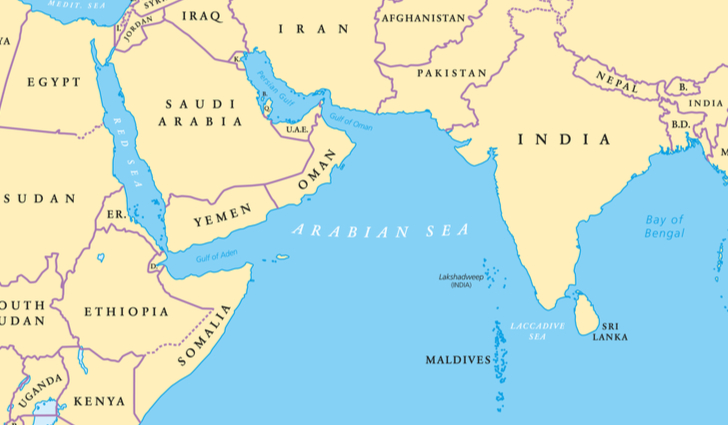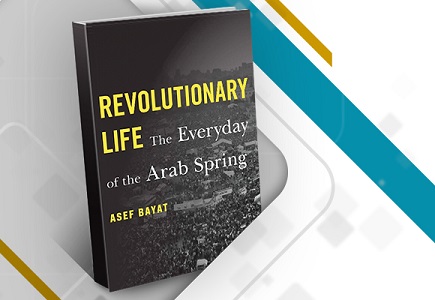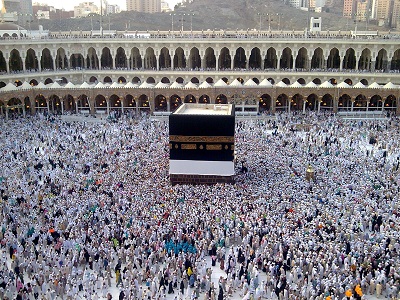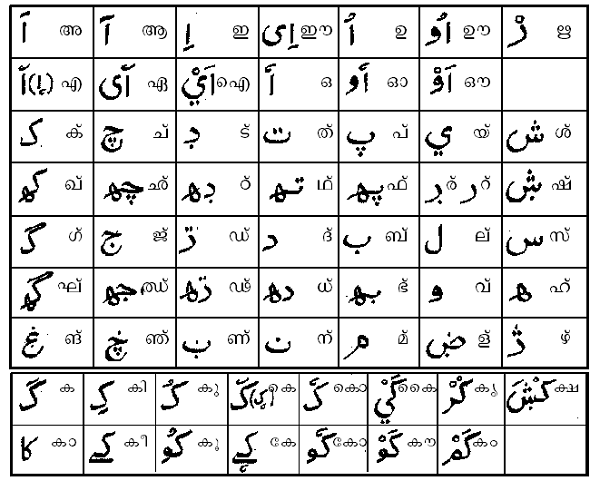
Introduction: India is gracefully rich land of races, religions, ethnicities, cultures and languages. It has a natural capacity to assimilate different religions and cultures; with it comes into contact and makes them its own. Religious- cultural syncretism is the distinctive feature of Indian civilization. The absence of a collective identity in Hinduism, the oldest among the Indian religions, has favoured the merger of different cultures. Hence, Hinduism ignored the religions of foreign origin that came to India through trade interactions, missionaries, invasions and conquests and never felt threatened even by the most fanatical and fundamentalist among them. The well-knit egalitarian community of Islam too underwent a miraculous transformation in the melting pot of socio- cultural milieu in India, so that it came to bear a stamp of its own in which variety is predominant.
Arabs had a close commercial and cultural relation with the Indians in pre-Islamic period. The Indo-Arab friendship dates back to the very ancient times in history when Indian and Arab sailors plied their ships across the seas and established commercial links with each other. As a result, Arab traders built their permanent settlements on the western coast of India which played a vital role in the exchange of Indo- Arab cultural relations. From the immemorial time, these two civilizations have also been in constant contact with the exchange of goods, ideas, cultures and people of each other. Through the passage of time, Indo- Arab relations have been on a distinctive trajectory with the massive movement of people from India to the Arab world and vice-versa in the form of pilgrimage and labour migration.
According to Jewish records, during the reign of King Solomon (c. 800 BC) ships would visit eastern ports every three years and bring back “gold and silver, ivory, apes, peacocks, Almug trees or Amlug trees and precious stones”. Their destination was the port of Ophir in India, identified with Sopara, in Thane district, near Mumbai. On the other hand, it is also assumed about Ophir, the most likely location on the coast of Kerala conjectured to be Ophir is Poovar in Thiruvananthapuram district, although some Indian scholars also suggested Beypore as possible location. The navigational activity across the Indian Ocean was facilitated by the knowledge of the monsoon winds. Indian ships moved out of the port of Broach in Gujarat for Arab and African coastal towns carrying wood, rice, edible oil, cotton and honey, and brought back pearls, dates and wine. The teak wood used by Omani and Yemeni sailors to make their boats came from Malabar, on the western coast of Kerala. While, the gulf Arab ports imported cloths, foods tuffs, wood and metal from India, pearls were the principal item exported from the gulf Arab to India from where they were sold world-wide. Indian ports had become banking centres for the Arabs trade, while the Indian rupee was commonly used in gulf Arab ports from the 17th century, a situation that continued till the 1960s. The gulf Arab region’s economic dependence on India and India’s profound cultural and political influence in the region up to 1947 was such that locals regarded India and Indians as highly as they now regard the West and Westerners.
To understand how the Arabs and Indian came into contact of each other, how the interactions of Arabs and Indians in the field of culture, religion and trade, and which extent, Islam and Muslims have influenced the Indian culture, custom and tradition, arts and architecture etc. I have tried to elaborate these accounts of relations and influence in historical parameter in this paper.
Amalgamation and Influence of Indo Arab culture: India had never aspired to live in isolation and always kept its doors open for the people and cultures from across the world. The philosophy of tolerance and coexistence of all faiths and races had been the essence of its civilization. It remained a melting pot for the world’s culture and civilization in give and take approach. The constant interaction between India and the Arab world was dynamic, diverse and multi- dimensional. However, the impact and power of this interaction was very much visible and long-lasting in the domain of culture, thoughts and religion. The cultural linkages in the past, in fact, have brought these two regions more close to each other and provided a base to maintain the relationship of similar sort in the contemporary times.
There are a lot of historical evidences for this time tested cultural connection. As we find in the religious sources, the first human being, Adam is believed to have landed in Ceylon (Sri Lanka) and reached Arabia via India. Finally, he met Eve in Saudi Arabia. Adam is believed to have landed in Dajna (that is Dakshin in Hindi) which means south. Adam was landed in India from the heaven of sky and dwelled here hundred years. He set his first step in Sri Lanka, which was a part of the greater India at that time.
Several goods like perfumes and spices were moved to the Arab world from South India. It is said that these are the golden memories of gifts of first human being Prophet Adam who brought from heaven. Besides, dates: lemon, banana and guava are also considered among his gifts which are found in India. As well as with the impression of diverse religion and cultural diversity and wonderful scientific and legendary assets, Indian Muslims are counted one of the four nations with excellent characteristics and rich cultural dimension: Persians, India, Romans, and China. For instance, a renowned Arabic scholar Al-Jahiz has also said about them: “India is best known for its arithmetic, astrology, and the mysteries of medicine, maps, wood, images, and the many wonderful industries.
The Old Testament bears ample evidence of maritime mercantile relations between India and Arab world during Solomon’s period. The Arabs had a close commercial and cultural relation with the Indians in pre- Islamic period. The Indo- Arab friendship dates back to the very ancient times in history when Indian and Arab sailors plied their ships across the seas and established commercial links with each others. In the result, Arab traders built their permanent settlements on the western coast of India which played a very important role in the exchange of Indo- Arab cultural relations. The Arab traders who settled on the coast, they inter married with the local women and established themselves on the coast of western India. The descendants of those Arab merchants had built up a prosperous trade between India and western world. The ‘Nawait” community of the Konkan and the ‘Labbais’ of the east Tamil coast are also the descendant of Arab merchants who had established themselves in these parts of the country long before the Muslim conquest of India and were expert in the field of sailing and seafaring works.
Thus, Arab merchants played a central role in the establishment of trade relations between India and the Roman Empire, as also between India and Egypt. Egypt imported precious stones, spices, incense and muslin either directly from India through Arab merchants or through Indian merchants settled at different Arab ports, such as Aden and Socotra.
Therefore, before the advent of Islam, the people of India and West Asia had already been trading with each other for over 2000 years, had lived for long periods in each other’s lands, and were familiar with each other’s religion, culture, custom and traditions, social norms and values and way of life. With the coming of religion of Islam, not only was the mercantile relationship enhanced, but a deeper relationship, encompassing religious and cultural affiliation was initiated and in time consolidated, which effects and influence are still seen in the life and cultural traditions of each others. In this way, India had a considerable influence on cultural life of Arabs in the gulf regions in terms of local architecture, clothing and cuisine, with Indian- style buildings have been dominating the gulf coastlines, Indian headdresses are being used by gulf Arabs, and Kashmiri shawls being used as turbans by the sections of Arab gulf royalty. Again, gulf Arabs and Iranians liked the Indian dishes very much and eat curried lamb and fish with Indian rice with appetizing test. In due course, the delicious test of Indian biryani, chicken Tanduri, Seekh Kabab and even the humble Samosa have become the standard items of gulf Arab cuisine .
Coming across the impression and consciousness of contributions and influence of Islam and Muslims on Indian culture in the middle age which has been envisaged and visualized in detail by both Muslim and non Muslim scholars. The ideas and thoughts of the several scholars and authors have also revealed the penetrating effects of Islam and its followers on the Indian culture and religion. Although, we find account of the authors have unanimously agreed with the contribution and influence of Islam and Muslims on Indian culture, but few scholars and writers have showed reservations in anticipating its influence on Indian religion. The scholars have asserted the emergence of a composite Indian culture borne by the amalgamation of Hindu and Muslim cultures. The process of identification and promotion of this composite culture received its impetus from the freedom movement of India. Hence the scholars and authors of that era project the synthesis of both Hindu and Muslim in India. The contribution of Islam to India is conceded in several domains of society, polity and economy. In the realm of society the contribution of Islam is accepted in the loosening of the rigid caste system. Emergence of nationalism or composite cultural resistance to the colonial powers recorded a notable contribution of Muslims. Muslim fraternity enriched the economic share of Indian culture in the medieval times. Many authors both Muslims and non Muslims have recorded various contributions and influence in this regard. However, the influence of Islam on Hindu religion has also vehemently been rejected by few scholars and authors.
Therefore, when we discuss about the contribution and influence of Islam and Muslims on Hindu thoughts and culture in India, then it can be perceived and summarized in the few statistics and information provided by the scholar like Tara Chand and others as well historical records also present such valuable information. “As the historical account shows that the Muslims made their advent in South India on the western coast as early as the eighth century if not earlier, and in the tenth century on the eastern coast; that they soon spread over the whole coast and in a comparatively short time acquired great influence both in politics and in society. On the one side their leaders became ministers, admirals, ambassadors and farmers of revenue, and on the other side, they made many converts, propagated their religious ideas, established mosques and erected tombs which became centres of the activities of their saints and missionaries. It may, therefore, be premised without overstraining facts that if, in the development of the Hindu religions in the south, any foreign elements are found which make their appearance after the seventh century, and which cannot be accounted for by the natural development of Hinduism itself, they may with much probability be ascribed to the influence of Islam, provided, of course, they are not alien to its genius". The spread of religion and Hindu system has a big incorporation of Muslim thoughts in Tara Chand’s opinion, as he said "The progress of religious thoughts in the south reveals a growing absorption of Muslim ideas into Hindu systems" furthermore, He explained it: "the philosophies of Sankara, of Ramanuja and others had their roots in the systems of the past, their presentation was original, but in the case of the latter it appears probable that they did not grow up utterly regardless of the new currents of thoughts which then flowed in the country. But if in their case it is only possible to give a judgement which must be largely conjectural, the evidence leaves almost no doubt that the Virsaivas and the Siddhars were largely influenced by Islam".
In the evolution of a distinct Indian culture we also find adequate support from Muslims. The Muslims who came into India and made it their home, they had been living surrounded by the Hindu people, subsequently, a state of perennial hostility with them was impossible. Mutual intercourse led to mutual understanding. Many who had changed their faith differed little from those whom they had left. Thus, after the first shock of conquest was over, the Hindus and Muslims prepared to find a way to live as neighbours. The efforts to seek a new life led towards the development of a new culture which was neither exclusively Hindu nor purely Muslim. But it was indeed a Hindu- Muslim culture. Not only did Hindu religion, Hindu art, Hindu literature and Hindu science absorb Muslim elements, but the very spirit of Hindu culture and the very stuff of Hindu mind were also altered and the Muslim reciprocated by responding to the change in every departments of life".
Hence, When Muslims arrived in the country and made their permanent settlement into India. They were surrounded by the Hindu community; subsequently they started to live there in a combined sociable ambience. So it is a very difficult task to differentiate in the shares of effects and contribution of both Muslim and Hindu on each others. "in the give and take of culture between Muslims and Indians it is very difficult to assess accurately the share of each others, it is true that the Muslims received many ideas from India and perhaps India received through Islam a reflection of its own contribution, It is true that Christian and neo-Platonist thoughts deeply coloured Islam and therefore some writers have found in Hinduism traces of those systems. But the fact remains that a number of elements were absorbed into Hinduism through its direct contract with Islam and these elements were presented to India impressed with the Islamic mould".
After the fourteenth century onwards an attempt of approximation between Hindu and Muslim faith were made by both the sides. This synthesis had its effect on Hindu religion, art, literature and science which absorbed many Muslim elements in the field of literature and it was the effect of Muslims in India that indigenous literary medium like the Urdu and the Hindi language was established. In the field of science: "Hindu astronomers took from the Muslims a number of technical terms, the Muslim calculations of latitudes and longitudes and various other items of the calendar (Zich) and in horoscopy a whole branch which they called Tajik. Hindu medicine borrowed from the Muslims the knowledge of metallic acids and many processes in astro-chemistry and arts". of the many "crafts and arts that the Muslim introduced in India, mention may be made of the manufacture of paper, of enamelling and faience, many woven stuffs and damascening" Muslim domination tended to create a political uniformity, equality and a sense of larger allegiance." the most vivid and picturesque contribution of Islam can be seen in "customs, in intimate details of domestic life, in music, in the fashion of dress, in the ways of cooking, in the marriage ceremonial, in the celebration of festivals and fairs, and in the courtly institutions and etiquette of Marathi, Rajput and Sikh princes". It has been assumed that Islam and Muslims caused a great change in India. While in the economic life of India this change was considerable, in the social and political life, they were great.
The scholars have also acknowledged the Muslim contribution in Bengal, "When the Muslim conquest took place; it gave a definite check to Brahmanism, but encouraged the half suppressed ancient cults, stimulated the movement of reform, and encouraged the growth of Bengali literature." with the reference of Dinesh Chandra Sen’s book “History of Bengali Language and Literature - page 12”, Tara Chand has mentioned: "The Muslim rulers of Bengal appointed scholars to translate the Ramayana and the Mahabharata from Sanskrit into Bengali which they spoke and understood easily. The translation of the Mahabharata was undertaken at the order of Nasir Shah who ruled at Gaur till 1325 A.D." The strong belief of Islam in a personal God had to be counteracted in this country by forms of religion in which the personal element of divinity predominated. So, the Sakta and the Vaisnava religions flourished and the Saiva religion with the impersonal ideal and mysticism in which man rose to the level of his God in the Advaitvada, was gradually thrown into the background, as the masses did not comprehend its speculative features." Such instances of interaction of Hinduism and Islam gave rise to the syncretic cults and practices. As, "the Hindus offered sweets at Muslim shrines, consulted the Holy Quran as an oracle, kept its copies to ward off evil influences with similar acts". It was the teachings of Islam that has influenced the movement started by Chaitanya. In this regard, Tara Chand has written with the quotation of Ranade’s book: Rise of the Maratha Power, page. 50-51. "The severity of the monotheistic creed of the Mohammadan was distinctly impressed upon the minds of these prophets (Kabir, Nanak and others). The worshippers of Dattatraya or the incarnation of the Hindu Trinity often clothed their God in the garb of a Mohammadan Faqeer. The same influence was at work with greater effect on the popular mind in Maharashtra, where preachers, both Brahmans and non- Brahmans were calling the people to identify Rama and Rahim and ensure their freedom from the bonds of formal ritualism and caste distinctions, and unite in common love of man and faith in God".
Conclusion: Arabs had a close commercial and cultural relation with the Indians in pre-Islamic period. The Indo-Arab friendship dates back to the very ancient times in history when Indian and Arab sailors plied their ships across the seas and established commercial links with each other. Furthermore, we can imagine that, when they plied their ships across the seas and spent several months together on the seas. Then, how it was possible to them leave no any effect and impression on each others. From the immemorial time, these two civilizations have also been in constant contact with the exchange of goods, ideas, cultures and people of each other. The Muslims who came into India and made it their home, they had been living surrounded by the Hindu people, subsequently, a state of perennial hostility with them was impossible. Then they decided to live as neighbours in a combined sociable ambience. The efforts to seek a new life led to the development of a new culture which was neither exclusively Hindu nor purely Muslim, but it was indeed a blend of Hindu- Muslim culture. When they were living together as neighbours, they influenced each others with their own culture, custom and traditions, and then it is a very difficult job, how to differentiate in the shares of influence and contribution of both Muslim and Hindu on each others. But it has been assumed that Islam and Muslims caused a great change in India, while in the economic life of the country this change was considerable, in the social, cultural and political life, they were great.
Bibliography
Ghulam Ali Azad Bilgrami, Subhatul Marjan Fi Aasare Hindustan, Bombay
Nadwi Syed Sulaiman, Arab w Hind ke Ta’alluqat, (Indo Arab Relations) Darul Musannifin, Azamgarh U.P. (Masha’al Books Lahore, Pakistan, 2004)
Al- Jahiz, Al- Rasael
Al- Aara Magazine, Saudi Arabia, 2018
Sheikh Mohd Ekram, Aabe Kausar, Feeroz Sons Ltd, Pakistan, 1968
Tara Chand, Influence of Islam on Indian culture, Allahabad, 1941
Saikia Mohini Kumar, Assam Muslim Relation and its Cultural Significance, Gauhati, 1978




